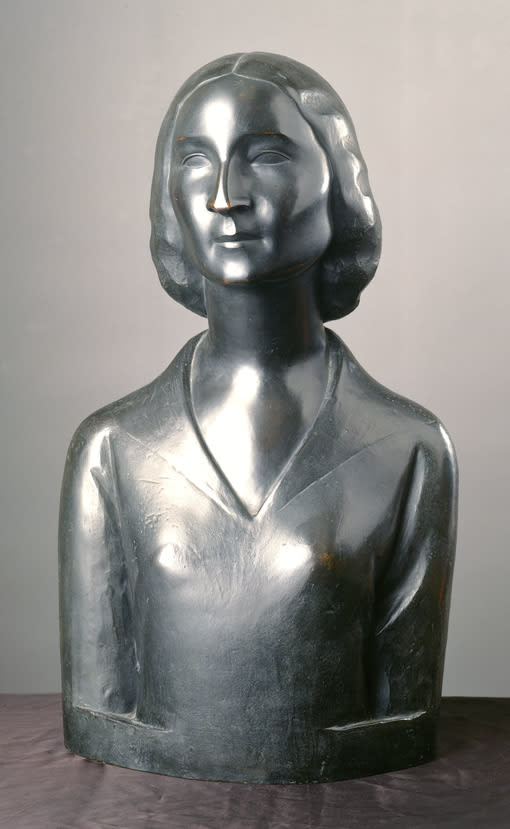
- Artist/Maker:
- Chana Orloff
- Bio:
- French, b. Ukraine, 1888-1968
- Title:
- Portrait of Madame Peretz Hirshbein
- Date:
- 1924
- Medium:
- Bronze
- Dimensions:
- 24 × 13 × 9 in. (61 × 33 × 22.9 cm)
- Credit Line:
- Gift of Erich Cohn
- Accession Number:
- JM 91-64
Not On View
In the early decades of the twentieth century, Paris acted as a magnet, attracting artists worldwide who came to study, pursue their art free from any traditional religious or ethnic restraints, and enjoy the cosmopolitan milieu. Among these foreigners was an extraordinary group of Jews, many from Eastern Europe, who made impressive contributions to French modernist art. By 1913, this Jewish contingent, part of the School of Paris, included Elie Nadelman from Poland, Marc Chagall from Russia, Jacques Lipchitz and Chaim Soutine from Lithuania, Sonia Delaunay-Terk and Chana Orloff from the Ukraine, and Amedeo Modigliani from Italy. These émigrés, who lived and worked in Montparnasse, forged strong personal and professional ties.
Orloff arrived in Paris in 1910 via Palestine, where her family had settled, and quickly entered the vibrant circle of artists in Montparnasse. Her elegant, highly stylized sculptures in wood and bronze, characterized by their simple volume, lyrical lines, and smooth rounded surfaces, brought her numerous portrait commissions. By the 1920s, she was riding a wave of success as a leading portraitist to fashionable Parisians and the cultural elite. She absorbed the avant-garde tenets of Cubism and prevailing influences of classical and "primitive" art and distilled them into reductive, sinuous forms.
In 1924, Peretz Hirshbein (1880-1948), a Yiddish playwright and novelist known for his pastoral romance Green Fields, commissioned Orloff to sculpt portraits of himself and his wife, the Yiddish poet Esther Shumiatcher (1899-1985). The couple had married in 1920 and traveled around the world for two years, a journey later chronicled in his book Around the World and her collection of poetry In the Valley.
Portrait of Madame Peretz Hirshbein displays the smooth surfaces and minimal detailing characteristic of the artist's work from this period. Orloff captures the intelligence and inner reserve of her subject and softens the severity of her high, angular cheekbones by slightly tilting her head. The artist conveys her continuing interest in fashion-she first worked as a sketcher with the couturier Paquin-by modeling the refined sailor-boy collar on Mme. Hirshbein's dress and the intricate, serpentine hair ornament. In the companion bust, Portrait of Peretz Hirshbein, the sitter's pronounced raised eyebrows, penetrating gaze, and firm mouth combine to emphasize the forcefulness of his character.
One year after executing these two powerful heads, Chana Orloff became a French citizen and was appointed Chevalier de la Légion d'Honneur. In her long, prolific career, she produced more than three hundred portraits of prominent European and Israeli artists, writers, and politicians besides other popular subjects like equestrian, dance, children, and music.
Orloff arrived in Paris in 1910 via Palestine, where her family had settled, and quickly entered the vibrant circle of artists in Montparnasse. Her elegant, highly stylized sculptures in wood and bronze, characterized by their simple volume, lyrical lines, and smooth rounded surfaces, brought her numerous portrait commissions. By the 1920s, she was riding a wave of success as a leading portraitist to fashionable Parisians and the cultural elite. She absorbed the avant-garde tenets of Cubism and prevailing influences of classical and "primitive" art and distilled them into reductive, sinuous forms.
In 1924, Peretz Hirshbein (1880-1948), a Yiddish playwright and novelist known for his pastoral romance Green Fields, commissioned Orloff to sculpt portraits of himself and his wife, the Yiddish poet Esther Shumiatcher (1899-1985). The couple had married in 1920 and traveled around the world for two years, a journey later chronicled in his book Around the World and her collection of poetry In the Valley.
Portrait of Madame Peretz Hirshbein displays the smooth surfaces and minimal detailing characteristic of the artist's work from this period. Orloff captures the intelligence and inner reserve of her subject and softens the severity of her high, angular cheekbones by slightly tilting her head. The artist conveys her continuing interest in fashion-she first worked as a sketcher with the couturier Paquin-by modeling the refined sailor-boy collar on Mme. Hirshbein's dress and the intricate, serpentine hair ornament. In the companion bust, Portrait of Peretz Hirshbein, the sitter's pronounced raised eyebrows, penetrating gaze, and firm mouth combine to emphasize the forcefulness of his character.
One year after executing these two powerful heads, Chana Orloff became a French citizen and was appointed Chevalier de la Légion d'Honneur. In her long, prolific career, she produced more than three hundred portraits of prominent European and Israeli artists, writers, and politicians besides other popular subjects like equestrian, dance, children, and music.
Information may change as a result of ongoing research.